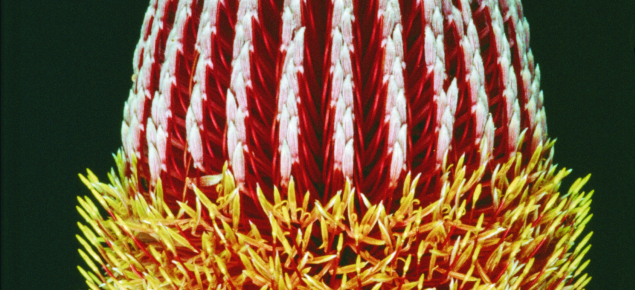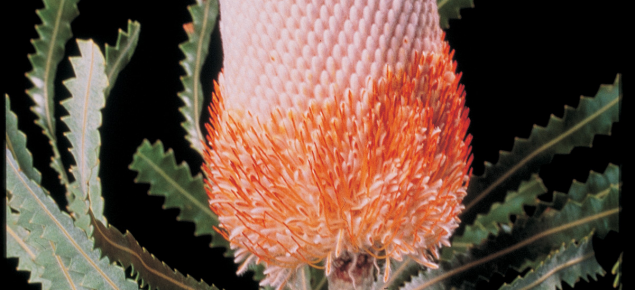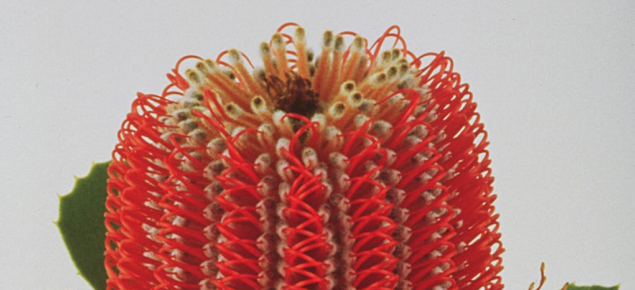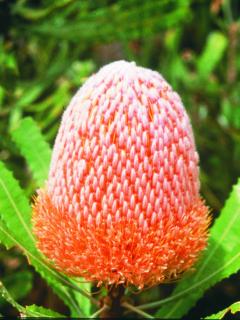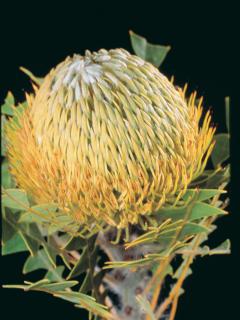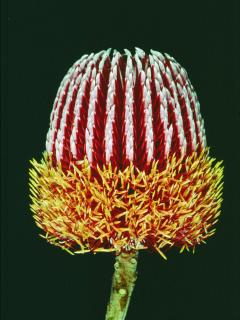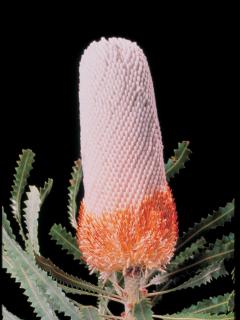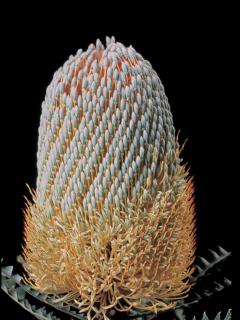Types of banksias
More than 12 species of Western Australian banksias are suited to cutflower production. These include Banksia hookeriana, B. coccinea, B. baxteri, B. prionotes, B. menziesii, B. speciosa, B. burdettii, B. attenuata and B. grandis.
Flowers range in colour from red (B. coccinea) to orange/white (B. prionotes). Depending on their origin, species are suited to different growing regions. For instance, B. coccinea and B. baxteri are best suited to the Albany-South Coast region and may not flower in the north of the state, while B. hookeriana and B. prionotes are more suited to hotter regions north of Perth. B. menziesii grows over a wide range of conditions but is particularly suited to the Perth-Capes area. Likely harvest times are shown in Table 1.
| Species/varieties | Harvest times |
|---|---|
| B. ashbyi | Jun-Dec |
| B. attenuata | Nov-Dec |
| B. baxteri | Sept-July |
| B. burdettii | Jan-Feb |
| B. coccinea | Apr-Nov |
| B. ericifolia | Apr-Sep |
| B. hookeriana | All year |
| B. menziesii | Feb-Oct |
| B. occidentalis | Dec-Apr |
| B. prionotes | Jan-Aug |
| B. sceptrum | Dec-Jan |
| B. seminuda | Apr-May |
| B. speciosa | Oct-Mar |
Banksia cultivation
Banksias grow well in deep, well drained, slightly acidic sands (pH 5.5-6.5), sometimes overlying limestone or gravel lenses. Highly alkaline soils are best avoided for most commercially grown species. Site selection for successful flower production is therefore important.
It is also important to soil test previous cropping land for residual phosphorus as banksias do not tolerate high levels idealy around 20 mg/L. Sites also need to be tested to be free of Phytophthora spp. dieback pathogen. To minimise the risk of introducing or spreading dieback, buy disease-free plants and apply basic quarantine measures. This includes fencing the site, and using foot and vehicle baths to stop soil movement from surrounding areas into the site.
Dieback affects the plant root system killing the crown and has the potential to kill plants at any age. It is also aggravated by poor drainage.
Sites should be free of weeds and control needs to be implemented well before planting.
If there is a requirement to deep rip the rows, do this before cultivating. But before any cultivation is attempted, make sure sufficient moisture is present to prevent wind erosion.
If soils are compacted, deep rip the beds to at least 600mm below the surface. Mound the planting bed where there is an issue with surface drainage. Mounding can also benefit the reduction of water-borne pathogens colonising the plant’s root system, such as Phytophthora and Pythium. This will raise the planting bed above the natural subsurface water flow. Also irrigation water drains more effectively from the root system. However on free draining sites and where no irrigation is applied, mounding should be avoided.
Grower experience indicates that single rows are generally easier to work and manage than double rows. However, some species such as B. coccinea when planted as two rows per bed, appear to give higher production results than those from single rows.
In-row plant spacings are determined by:
- species size at maturity
- irrigation or non-irrigation production
- Mechanical harvesting versus hand picking.
A rough guide for planting design is given for different species in Table 2.
| Species | Intra-plant distances (m) | Between-row distances (m) | Number of rows 1m apart in bed | Plant density (n/ha) |
|---|---|---|---|---|
| B. coccinea | 1-2 | 4 | 1 | 1250-2500 |
| B. coccinea | 1 | 4 | 2 | 2500 |
| B. hookeriana, B baxteri, B. menziesii | 2-3 | 4 | 1 | 833-1250 |
| B. prionotes, B. speciosa | 3-3.5 | 4 | 2 | 1429-1667 |
Planting out
Irrigation layout and mulching should be in place before commencing to plant out. The planting bed should also be thoroughly wetted up.
Banksia seedlings should be planted in late April to early May, or well before the winter impacts on soil temperature (less than 15°C). Alternatively, the seedlings could be planted in mid-spring, coinciding with increasing soil temperatures. Where delays in autumn planting occur, seedlings held over to spring should be re-potted into larger containers to avoid root binding issues.
To plant out without irrigation is possible in certain areas in autumn if there is a good chance of follow up rains to ensure sufficient root development before the summer dry period.
Use of mulches may aid plant establishment and growth, where organic and non-organic mulches can be used. Organic mulches can be well composted woodchips, coarse sawdust, or weed-free straw or cereal stubble. Organic mulches can allow beneficial soil organisms to build up. Some documentary evidence suggests that Phytophthora colonisation around the host root systems is greatly reduced through the development of antagonistic microbial activity under the decomposing straw.
The non-organic mulches consist of either a plastic film of varying micron thicknesses, or a woven plastic fabric known as Weedmat. This is more expensive but lasts three to four times as long as the film. If using plastic film it is important to have a well cultivated planting bed wherethe plastic is to be laid. This will enable the plastic layer attachment to tension the film correctly and eliminate the humps and hollows which develop. When cultivating avoid cultivation of inter-rows as this will reduce stimulating weed germination and diminish the risk of sand blasting and wind erosion as seedlings are established. The plastic film is usually associated with row mounding and/or deep ripping as it can be applied as a one pass operation during the mounding process.
There are a couple of negatives to plastic film:
- The film becomes an environmental hazard when it begins to break down over after a period of time. It will eventually require removal and disposal.
- Some winter irrigation may also be necessary as the plastic will shed some rainfall away from the row plantings.
However the advantage of using film lies with ease of management and application.
Windbreaks are essential for successful banksia establishment. If possible, establish natural windbreaks well before seedlings are planted.
Successful windbreaks are designed to reduce wind speed, which in turn reduces turbulence. Various woven plastic materials can be used to provide permanent wind protection.
Individual plastic tree guards or specialised plastic sleeves can also be used. Some management issues should be considered when using this form of wind protection. Close fitting sleeves or guards can harbour weevils and complicate hand weeding. If the guards remain in place for any length of time, plant growth may be affected. Often a soft spindly growth is produced. The plants then have a tendency to fall over when the guards are removed. Stem twisting and poor branch development will result, necessitating remedial pruning and staking. Using individual wind guards is still a good management choice if other options are not available.
The guards are cost effective and easy to install. However, it is important to use them only for a short period, generally the first six to eight weeks of establishment.


